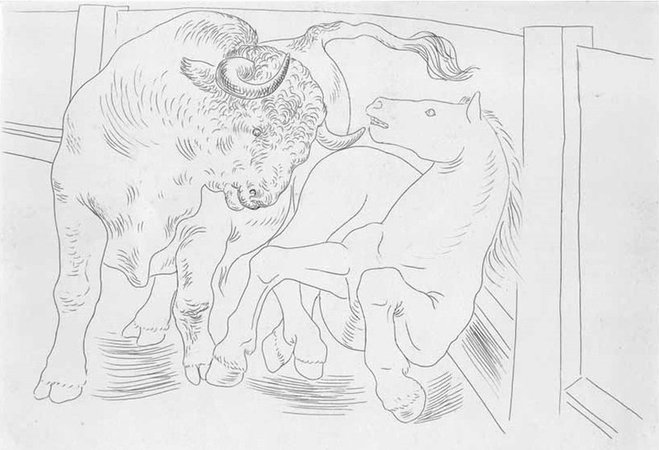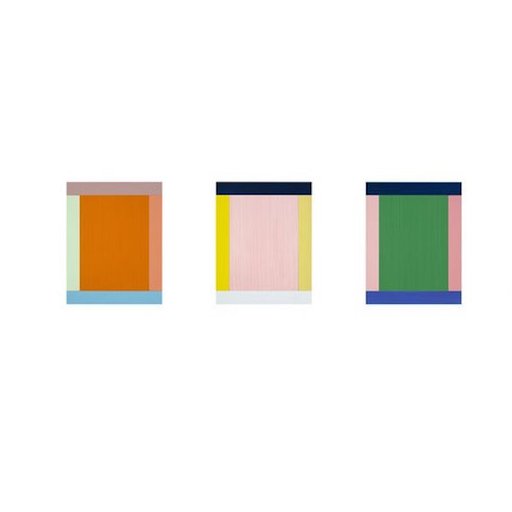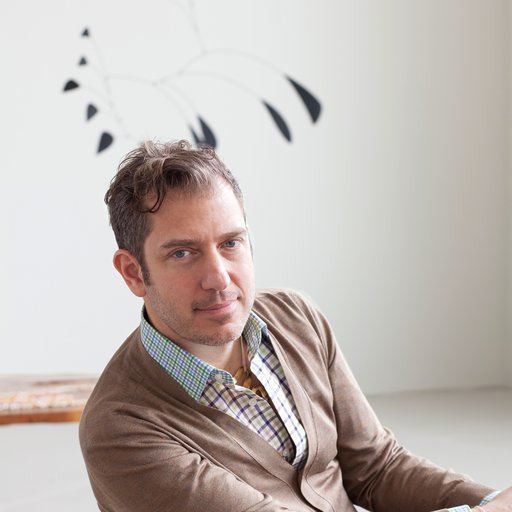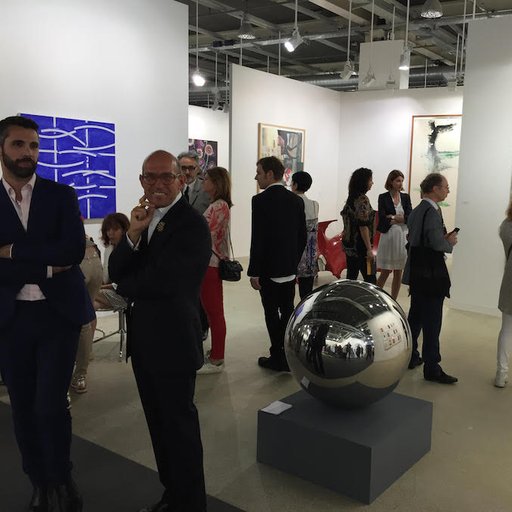The art historian Noah Charney knows a thing or two about fake artworks; as the author of several books about art crimes (includingThe Art of Forgery, out now via Phaidon Press) and the founder of the non-profit think tank the Association for Research into Crimes Against Art in Rome, Charney has a rare knowledge of the myriad ways in which art has been stolen, falsified, and otherwise desecrated. As it turns out, he also has an eye for picking out quality (and authentic) artworks as well. Here, the author tells us about 10 of his favorite works on Artspace.
PABLO PICASSO
Taureau et Cheval dans l'Arene, 1929

You’ve got to be careful with Picassos. He holds the dubious distinction of being the most frequently stolen, and most frequently forged, artist in history. In one night in 1976, 118 Picassos were stolen from the Papal Palace in Avignon by members of the Corsican Mafia (all but one was recovered—they didn’t know what to do with them, but found them all too easy to steal). And it is unfortunately easy to mistake a very high-quality laser print for an original lithograph, particularly if it’s nicely matted and framed. Not all vendors are as reliable as Artspace, so be sure to buy your Picassos from vendors that you trust, and don’t be shy about asking for provenance and, in person, to have works removed from their frames to check the backs of prints to make sure they look old, and to check for markings that indicate that the work has history (stamps from past sales, for example) and was not printed around the corner a week prior to the sale.
RICHARD SERRA
Untitled (#57), 2005

Richard Serra’s art, whether the medium is painting or sculpture, is about imposition into space. This work on paper is two-dimensional—of course it is, all works on paper are—and yet it feels three-dimensional, as if the black curves are projecting out at us, and are components of much larger, longer strips of metal. Like a snapshot of a Richard Serra sculpture, perhaps. The work makes you feel like you are too close to it, no matter where you stand. The ability of art to alter the way you were feeling just before you engaged with it is the mark of quality. Serra’s got it.
THOMAS RUFF
ma.r.s.05 III, 2012

What makes a photograph worth six figures? We think of photographs as infinitely reproducible, non-unique, and they have the capability of being just that. But when you limit the print series to three, as in this case with the Thomas Ruff photograph—which looks more painterly than photographic—then you are artificially inducing rarity. There is no scientific equation to determine the value of art. Sure, gallerists and auctioneers can look at the past sales prices for similar works and make an educated guess, but value comes down to a rough equation that looks something like this: value of art = perceived (rarity+authenticity+demand). A work must be believed to be authentic. There must be demand—it needn’t be lots of people, but at least two motivated collectors can drive up prices. And most works of art that we think of are unique, making them the definition of rare. Photographers can ratchet up the value of their work by keeping print runs small—rarity means value. And if a photographer is willing to destroy the negative—or file—to ensure that no more prints can possibly be made, then so much the rarer.
TRACEY EMIN
Get it, 2013

Tracey Emin may be best known for My Bed, but her drawings are powerful and remove any doubt (from those who dare to doubt) that she is an artist of top quality. Her works are startlingly sexual, and she intentionally blurs the lines between art and pornography—funny from someone who recently announced that she has been celibate for many years. Her drawings are part of an artistic continuum with erotic art (because of its explicit sexuality, the display of organs) with Egon Schiele and Pablo Picasso. All take full advantage of few lines—if you break down this drawing into strokes, there are not many of them. Do we need the erect phallus? I’d say not really, but this is the artist’s decision, to push the boundaries and titillate, and there is no denying the beauty of the piece.
ELSIE FERGUSON
Nyet, 2014

This work in plaster on panel, part sculpture part painting, points out the elephant in the room when dealing with art: that it’s all about optical illusion. Depending on how you look at this work, you can see the diagonal striations as projecting out in front of the vertical black and tan stripes, or you can see the opposite, the vertical in front of the diagonal. But both are illusions, tricks of the eye that the artist, like so many artists over the centuries, has played on us, because it is of course a largely two-dimensional object. There is a sense of "willing suspension of disbelief" required when encountering art. That phrase is usually associated with theater. You go to theater and willingly accept that you will withhold disbelief, that what happens on stage is "fake," and thereby allow yourself to immerse in the story and enjoy the experience more. It’s no fun if you keep reminding yourself that the play is all false, that they’re just actors. It’s the same with art; you voluntarily set aside the knowledge that a sculpture is just a lump of stone or wood, or a painting a board with pigment on it. Here, we allow our eye to be fooled into thinking that there is more depth to this two-dimensional work than there is. And the artist’s ability to manipulate us, in vision and mind, is the mark of a great work.
JEAN-MICHEL BASQUIAT
Untitled Drawing, 1978

I’m not a particular admirer of Basquiat’s work (I prefer very old traditional European painters, I’m afraid), but I write about a fascinating scandal in my book: a debate over the authenticity of a door, off of an alleyway in New York, which was the entrance to the lair of a drug dealer from whom Basquiat bought drugs towards the end of his brief life. He almost certainly did paint the door, but when the drug dealer, now long-reformed and a family man, tried to get the door authenticated by Basquiat experts (the painter’s father among them), they refused, for what seemed more personal/moral reasons than that the door’s painting was not authentic.
MARINA ABRAMOVIC
The Lovers (2 Vessels), 1988
This is a work that I know about personally, and from an insider’s perspective. I’m friendly with Ulay who, like me, married a Slovenian woman and lives on the “sunny side of the Alps,” in Ljubljana. I’ve admired Ulay’s work for years, and he’s a completely lovely, brilliant, humble man. There is a lot more to his relationship, professional and personal, with Marina Abramovic than has been made public—for a glimpse, I recommend the recent documentary film about Ulay’s battle with, and victory over, cancer: Project Cancer.
GEORGE WIDENER
Magic Square 12-21-2012 (Conspiracy), 2012

I’ve been fascinated with magic squares for years, ever since one featured as a key plot device in my first book The Art Thief. Magic squares are lines of non-repeating numbers wherein any entire line, vertical or horizontal, adds up to the same total, the “magic number.” The most famous example, and the one I used in my novel, appears in Albrecht Durer’s Melancholia I, one of my favorite artworks and a puzzle that, like the magic square, endlessly fascinates. The ancient Israelites thought that magic squares had supernatural powers, and wore amulets comprised of them into battle. Perhaps there’s something to it?
ANDY WARHOL
Red Lenin, 1987

Andy Warhol’s prints are interesting and iconic, but almost none of them are, to my eye, beautiful. Here is the exception. I don’t know if I’d want to spend decades staring at a Campbell’s soup logo in my living room, or even Elvis Presley’s face. But this shocking red, and the lightning bolt flash of Lenin’s abstracted face, is an aesthetic pleasure regardless of who created it, its intellectual or cultural interest, or one’s affinity with the gentleman portrayed.
YVES KLEIN
Table Bleu, 1961/1963

I rarely see something and think to myself “I must have you,” but such was the case with this remarkable table. A ceramic coffee table acts as a container/frame for Yves Klein blue pigment, possibly the world’s most beautiful man-made color. I’m not sure the table would actually go with any furniture I own, but it is so striking that it’s worth building a room around.



























